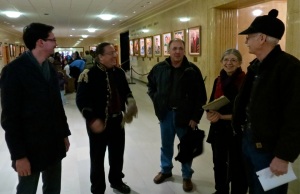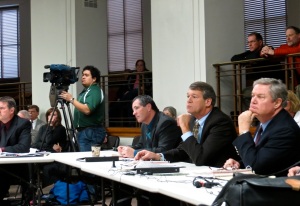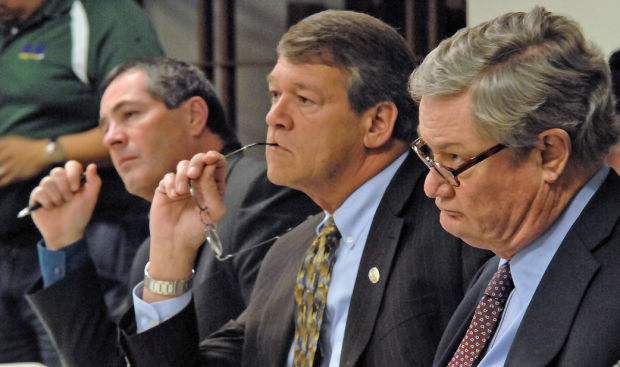Published January 29, 2013, 12:00 AM
Killdeer Mountain group unhappy with decision: IC to allow Hess to drill on disputed lands
It appears a disputed area of land in the Killdeer Mountains will be developed mostly as planned, but members of a group opposing oil drilling on the site said Monday they’re not done fighting.
By: Bryan Horwath, The Dickinson Press
It appears a disputed area of land in the Killdeer Mountains will be developed mostly as planned, but members of a group opposing oil drilling on the site said Monday they’re not done fighting.
The North Dakota Industrial Commission last week unanimously approved a request from Hess Corp. to drill up to eight wells in a part of the Killdeer Mountains area in Dunn County. Plans to allow Hess to drill in the area have been under attack by American Indians, area landowners and archaeologists since October when the first public hearing about the matter occurred.
Landowner Loren Jepson — who, along with wife Lori Jepson, helped create the Killdeer Mountain Alliance — said Monday that those interested in preserving the area are not giving up hope.
“I know a letter was sent out to (Hess CEO) John Hess requesting that they consider some different options,” Loren Jepson said. “I think we have some different avenues to take, but, before anything, we need to hear from Hess (Corp.).”
Opponents of drilling in the area have argued that the proposed wells would cause safety concerns with increased truck traffic, encroach on native habitat for wildlife and disturb an area called Medicine Hole, a well-known prayer retreat location for members of the Fort Berthold Indian Reservation and other Native Americans.
Biological consultant and researcher Anne Marguerite Coyle — known by many across the state as “The Eagle Lady” — believes that because the Industrial Commission previously had approved the first four wells near the sites in question put the IC in a difficult position.
“Approving those other wells was a big mistake and I think they now realize that,” Coyle said. “The system is flawed. There are no state regulations. There’s nothing in place to force the Oil and Gas Division to really do what they need to do before they permit these things.”
At the hearing last Thursday, North Dakota Department of Mineral Resources — which oversees the Oil and Gas Division — Director Lynn Helms stated that changing Hess’ course and leaving the area free from drilling would keep 3.5 million barrels of oil beneath the surface and squander $250 million. Before becoming employed by the state body responsible for regulating the drilling of oil and gas in North Dakota, Helms was employed for more than a decade by what is now Hess Corp.
“What’s happening is there is no communication between oil and gas and other agencies like the State Historical Society,” Coyle said. “Lynn Helms is both in charge of promoting and regulating oil, he worked for the Hess Corp. (Helms) should be in charge of promotion, but he’s not going to be suitable for regulatory issues — we need someone else in there.”
IC members argued that because the land in question is North Dakota Department of Trust Lands, they have an obligation to develop minerals in the area for the benefit of K-12 education in the state, which would receive money from the production of oil.
A number of stipulations were included with the IC’s approval, including instructions for Hess to limit natural gas flaring and a request for Hess to work with the Jepsons in an effort to limit impacts on area residents. The Jepsons’ attorney, Tom Gehrz of Mackoff Kellogg, said it could be known by the end of the week what steps could be taken by his clients to continue their resistance.
Coyle said the KMA will continue to work toward a “better solution.” The IC is comprised of Gov. Jack Dalrymple, Agriculture Commissioner Doug Goehring and Attorney General Wayne Stenehjem.
http://www.thedickinsonpress.com/event/article/id/65192/
The North Dakota Industrial Commission last week unanimously approved a request from Hess Corp. to drill up to eight wells in a part of the Killdeer Mountains area in Dunn County. Plans to allow Hess to drill in the area have been under attack by American Indians, area landowners and archaeologists since October when the first public hearing about the matter occurred.
Landowner Loren Jepson — who, along with wife Lori Jepson, helped create the Killdeer Mountain Alliance — said Monday that those interested in preserving the area are not giving up hope.
“I know a letter was sent out to (Hess CEO) John Hess requesting that they consider some different options,” Loren Jepson said. “I think we have some different avenues to take, but, before anything, we need to hear from Hess (Corp.).”
Opponents of drilling in the area have argued that the proposed wells would cause safety concerns with increased truck traffic, encroach on native habitat for wildlife and disturb an area called Medicine Hole, a well-known prayer retreat location for members of the Fort Berthold Indian Reservation and other Native Americans.
Biological consultant and researcher Anne Marguerite Coyle — known by many across the state as “The Eagle Lady” — believes that because the Industrial Commission previously had approved the first four wells near the sites in question put the IC in a difficult position.
“Approving those other wells was a big mistake and I think they now realize that,” Coyle said. “The system is flawed. There are no state regulations. There’s nothing in place to force the Oil and Gas Division to really do what they need to do before they permit these things.”
At the hearing last Thursday, North Dakota Department of Mineral Resources — which oversees the Oil and Gas Division — Director Lynn Helms stated that changing Hess’ course and leaving the area free from drilling would keep 3.5 million barrels of oil beneath the surface and squander $250 million. Before becoming employed by the state body responsible for regulating the drilling of oil and gas in North Dakota, Helms was employed for more than a decade by what is now Hess Corp.
“What’s happening is there is no communication between oil and gas and other agencies like the State Historical Society,” Coyle said. “Lynn Helms is both in charge of promoting and regulating oil, he worked for the Hess Corp. (Helms) should be in charge of promotion, but he’s not going to be suitable for regulatory issues — we need someone else in there.”
IC members argued that because the land in question is North Dakota Department of Trust Lands, they have an obligation to develop minerals in the area for the benefit of K-12 education in the state, which would receive money from the production of oil.
A number of stipulations were included with the IC’s approval, including instructions for Hess to limit natural gas flaring and a request for Hess to work with the Jepsons in an effort to limit impacts on area residents. The Jepsons’ attorney, Tom Gehrz of Mackoff Kellogg, said it could be known by the end of the week what steps could be taken by his clients to continue their resistance.
Coyle said the KMA will continue to work toward a “better solution.” The IC is comprised of Gov. Jack Dalrymple, Agriculture Commissioner Doug Goehring and Attorney General Wayne Stenehjem.
http://www.thedickinsonpress.com/event/article/id/65192/






.jpg)





